Which Of The Following Animals Is Not One Of The Most Common Animals Connected To Pastoral Nomadism?
Pastoralism is a subsistence blueprint in which people brand their living by tending herds of large animals. The species of animals vary with the region of the world, merely they are all domesticated herbivores ![]() that normally live in herds and eat grasses or other abundant constitute foods. Horses are the preferred species by nigh pastoralists in Mongolia and elsewhere in Central Asia. In Due east Africa, it is primarily cattle. In the mountainous regions of Southwest Asia, it is mainly sheep and goats. It is often camels in the more arid lowland areas of the Southwest asia and North and East Africa. Among the Saami
that normally live in herds and eat grasses or other abundant constitute foods. Horses are the preferred species by nigh pastoralists in Mongolia and elsewhere in Central Asia. In Due east Africa, it is primarily cattle. In the mountainous regions of Southwest Asia, it is mainly sheep and goats. It is often camels in the more arid lowland areas of the Southwest asia and North and East Africa. Among the Saami ![]() people (or Lapps
people (or Lapps ![]() ) of northern Scandinavia, it is reindeer. Some pastoralists in northern Mongolia as well herd reindeer. While the Saami mostly utilise their reindeer as a source of meat, the Dukha
) of northern Scandinavia, it is reindeer. Some pastoralists in northern Mongolia as well herd reindeer. While the Saami mostly utilise their reindeer as a source of meat, the Dukha ![]() people (or Tsaatan
people (or Tsaatan ![]() ) of northern Mongolia milk and ride their reindeer much every bit other Mongolians do with horses.
) of northern Mongolia milk and ride their reindeer much every bit other Mongolians do with horses.
| Traditional pastoralist regions | 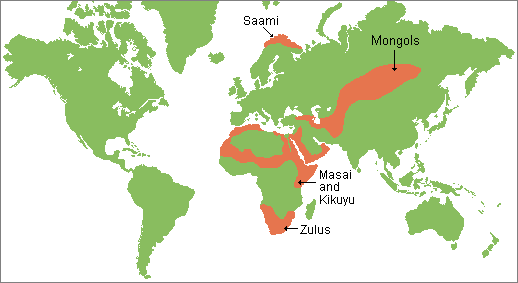 |
| | 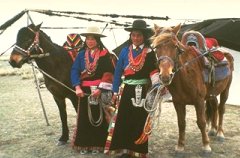 | |
| Mongolian horse pastoralist camp | ||
In that location are substantially two forms of pastoralism. They are known as nomadism and transhumance. Pastoral nomads ![]() follow a seasonal migratory pattern that can vary from twelvemonth to twelvemonth. The timing and destinations of migrations are determined primarily by the needs of the herd animals for water and fodder. These nomadic societies practice not create permanent settlements, but rather they alive in tents or other relatively easily constructed dwellings the year round. Pastoral nomads are ordinarily self-sufficient in terms of food and nearly other necessities.
follow a seasonal migratory pattern that can vary from twelvemonth to twelvemonth. The timing and destinations of migrations are determined primarily by the needs of the herd animals for water and fodder. These nomadic societies practice not create permanent settlements, but rather they alive in tents or other relatively easily constructed dwellings the year round. Pastoral nomads are ordinarily self-sufficient in terms of food and nearly other necessities.
| | |
| Near Eastern transhumance nomads |
Transhumance pastoralists ![]() follow a cyclical
follow a cyclical ![]() pattern of migrations that usually have them to absurd highland valleys in the summer and warmer lowland valleys in the winter. This is seasonal migration betwixt the same ii locations in which they have regular encampments or stable villages often with permanent houses. Transhumance pastoralists unremarkably depend somewhat less on their animals for food than do nomadic ones. They ofttimes do small scale vegetable farming at their summer encampments. They also are more probable to trade their animals in town markets for grain and other things that they exercise not produce themselves.
pattern of migrations that usually have them to absurd highland valleys in the summer and warmer lowland valleys in the winter. This is seasonal migration betwixt the same ii locations in which they have regular encampments or stable villages often with permanent houses. Transhumance pastoralists unremarkably depend somewhat less on their animals for food than do nomadic ones. They ofttimes do small scale vegetable farming at their summer encampments. They also are more probable to trade their animals in town markets for grain and other things that they exercise not produce themselves.
Not all pastoralist societies can be accurately described as following a nomadic or transhumance way of life. As weather alter, pastoralists normally accommodate. This tin can result in a traditionally nomadic lodge or some families inside in information technology becoming more or less transhumance in their migratory patterns if the opportunity arises. Likewise, a society that prefers a transhumance way of life may be forced by circumstances to change to a nomadic pattern for some or all of its livestock.
Pastoralism is most oftentimes an adaptation to semi-arid open country in which farming tin can not be easily sustained without importing irrigation water from keen distances. Pastoralism is usually the optimal subsistence pattern in these areas because it allows considerable independence from any particular local surroundings. When at that place is a drought, pastoralists disperse their herds or move them to new areas. Farmers rarely have these options. They suffer ingather failure and starvation in the same situation. A pastoral subsistence blueprint reduces the risk when there is an irregular climatic blueprint. This is especially true of nomadic pastoralism.
The animals herded past pastoralists are rarely killed for family unit utilize solitary. Fresh meat is distributed throughout the community. This is the about efficient use of their animals because they normally do non take the adequacy of adequately preserving meat. Not just does information technology ensure that no spoilage takes place, but information technology also sets up numerous obligations to reciprocate ![]() inside the customs. It promotes cooperation and solidarity. Oftentimes the slaughter of an animate being is for a ritual occasion so that its death serves multiple purposes. It feeds both the gods and the people. Most pastoralists also become food from their animals without killing them. Horses, goats, sheep, cattle, and camels are milked. In Eastward Africa, cattle herding societies besides bleed their animals. The blood is mixed with fresh milk to make a protein rich drink.
inside the customs. It promotes cooperation and solidarity. Oftentimes the slaughter of an animate being is for a ritual occasion so that its death serves multiple purposes. It feeds both the gods and the people. Most pastoralists also become food from their animals without killing them. Horses, goats, sheep, cattle, and camels are milked. In Eastward Africa, cattle herding societies besides bleed their animals. The blood is mixed with fresh milk to make a protein rich drink.
Pastoralist societies about often have patrilineal descent ![]() patterns and are male dominated. Men ordinarily make the of import decisions and own the animals, while women primarily treat children and perform domestic chores. Compared to pedestrian foraging societies, the economic and political power of most pastoralist women is very low. Withal, the division of labor is based primarily on gender and historic period in both foraging and pastoralist societies.
patterns and are male dominated. Men ordinarily make the of import decisions and own the animals, while women primarily treat children and perform domestic chores. Compared to pedestrian foraging societies, the economic and political power of most pastoralist women is very low. Withal, the division of labor is based primarily on gender and historic period in both foraging and pastoralist societies.
Pastoralist Personality Traits
| | |
| Due east African pastoralist |
Pastoralists often accept the same distinct qualities of personality regardless of the region of the globe in which they live. Specifically, men in a local grouping tend to be cooperative with each other and aggressive towards outsiders. They usually tin make of import economic decisions quickly and deed on them independently. They have a profound emotional attachment to their animals. A pastoralist leader needs to exist a man who can direct the movements of his herds and decide on an optimum strategy for using scarce resources without having to commencement consult others. He needs to make decisions easily and to act on them without hesitation. He needs to exist able to take the initiative and to exist a leader in aggressively defending his herd past expanding territory at the expense of others. He must e'er be realistic in his appraisement of the world. To do these things, he needs to have an mental attitude of cocky-containment, personal command, and bravery. These typical pastoralist personality traits are related to subsistence success. Every bit a consequence, boys are encouraged to emulate them every bit they abound upwardly.
Men in pastoralist societies unremarkably acquire prestige and power past existence dauntless and successful in predatory raids as well as by accumulating large herds of animals. Teenagers and young men oft are the customs'south bachelor warriors. This is especially the case amongst the Masai ![]() , Kikuyu
, Kikuyu ![]() , and other cattle herders of East Africa. They usually do not brainstorm to larn their ain herds until they become elders. As a result, there are oftentimes smashing status differences between young and old men. It is the older men who marry the immature women. Polygyny
, and other cattle herders of East Africa. They usually do not brainstorm to larn their ain herds until they become elders. As a result, there are oftentimes smashing status differences between young and old men. It is the older men who marry the immature women. Polygyny ![]() is a common pastoralist matrimony blueprint.
is a common pastoralist matrimony blueprint.
Pastoralist Military Conquests
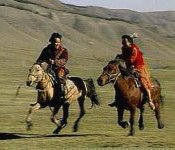 | |
| Mongol men riding their sturdy modest horses |
Pastoralists have often been successful conquerors of agricultural societies. This has been especially true of the Mongol equus caballus pastoralists and the cattle herders of East and South Africa. The Mongol ![]() light cavalry-based armies with their powerful brusk bows speedily conquered China and Central Asia in the 13th century A.D. During the 14th century, they also seized control of Persia, Iraq, much of Russia, and the northern parts of South Asia. Across this vast expanse, the threat of their invasion caused many nations to pay the Mongols large tribute payments. In East Africa, pastoralists established important kingdoms from Republic of uganda and Rwanda to South Africa. Perhaps, the nigh famous African pastoralist conquerors were the Zulus
light cavalry-based armies with their powerful brusk bows speedily conquered China and Central Asia in the 13th century A.D. During the 14th century, they also seized control of Persia, Iraq, much of Russia, and the northern parts of South Asia. Across this vast expanse, the threat of their invasion caused many nations to pay the Mongols large tribute payments. In East Africa, pastoralists established important kingdoms from Republic of uganda and Rwanda to South Africa. Perhaps, the nigh famous African pastoralist conquerors were the Zulus ![]() . During the 1830'south, they began an intermittent war with the Dutch settlers of Due south Africa (i.e., the Boers
. During the 1830'south, they began an intermittent war with the Dutch settlers of Due south Africa (i.e., the Boers ![]() ) after defeating several African farming peoples. The Zulus were finally subdued with great difficulty past the British ground forces in 1879.
) after defeating several African farming peoples. The Zulus were finally subdued with great difficulty past the British ground forces in 1879.
The pastoralist success in state of war has been due to several things. They usually accept the ability to operate in a big social context and to accept the accented authority of their leaders. They value extreme bravery and train their children accordingly. Pastoralist armies can easily wage prolonged wars because they are independent of lines of supply from home bases. The Mongols took their herds of horses to state of war with them. In fact, they rode their horses into boxing. Pack horses carried their tents and provided much of their food (in the form of mare's milk). This meant that the Mongols had highly mobile cavalry units. They also let their herds loose to feed in the farm fields of the people they conquered. Not simply did this fatten upwards their horses, merely it too economically weakened their enemies.
Pastoralism Today
It is likely that pastoralists volition not take the same fate every bit foraging societies. Pastoralism will go on for the well-nigh future in poor nations, particularly in Central Asia, because it is generally an efficient, low free energy requiring subsistence base of operations for semi-arid regions. During the 20th century, withal, most national governments tried to force pastoralists to stop their migrations and to reduce the size of their herds in club to foreclose over-grazing. These efforts at controlling them were consistently resisted by pastoralists. Big herds were ordinarily seen by them equally symbols of wealth and as security against unpredictable climates and periodic epidemics among their animals. Conservation has non been traditionally of import for pastoralists considering they migrated over vast areas and could easily move on when grasses and h2o were depleted.
Postscript
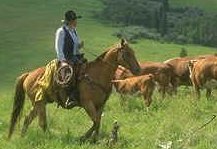 | |
| Modern cattleman in Western America | |
A modern grade of pastoralism is practiced by cattle and sheep ranchers in Western North America, Commonwealth of australia, New Zealand, Argentine republic, and a few other areas of the world. However, these ranchers are non subsistence pastoralists. They are businessmen who produce a article for national and international markets. They also use mechanized equipment such equally trucks and fifty-fifty airplanes and helicopters in their work. Despite the differences, there are major similarities in the fashion of life and personality between modern and traditional pastoralists. Both approach the world equally high adventure takers. Their livelihoods can quickly exist lost to theft, diseases, or other natural disasters. On the other manus, their herds can double in a few years making them rich. Modern pastoralists likewise adore men who are confident, cocky-reliant, and dauntless. At that place has been a hit similarity as well between 19th and early on 20th century American cowboys and traditional subsistence pastoralists elsewhere around the world in their disdainful attitudes virtually farmers and fences. Hollywood has immortalized this story of strained relations betwixt "sod-busters" and "cattlemen" in many western genre films.
This page was last updated on Wed, Dec 21, 2011 .
Copyright © 2001-2011 by Dennis O'Neil. All rights reserved.
Illustration credits
Source: https://www2.palomar.edu/anthro/subsistence/sub_3.htm
Posted by: arellanoexproul.blogspot.com

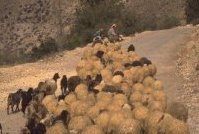
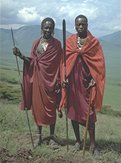
0 Response to "Which Of The Following Animals Is Not One Of The Most Common Animals Connected To Pastoral Nomadism?"
Post a Comment